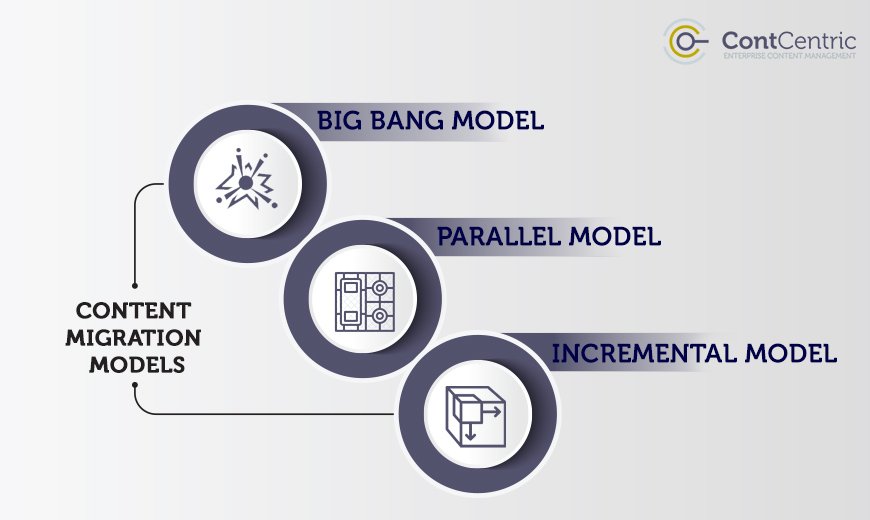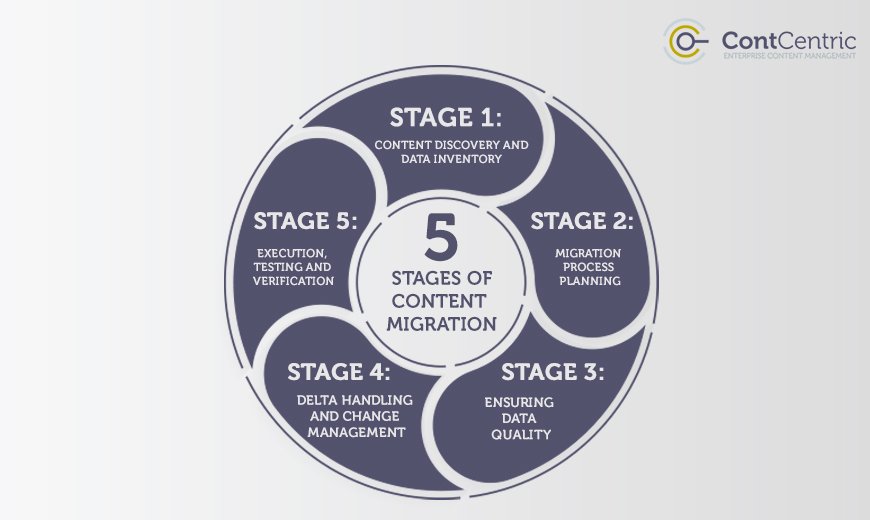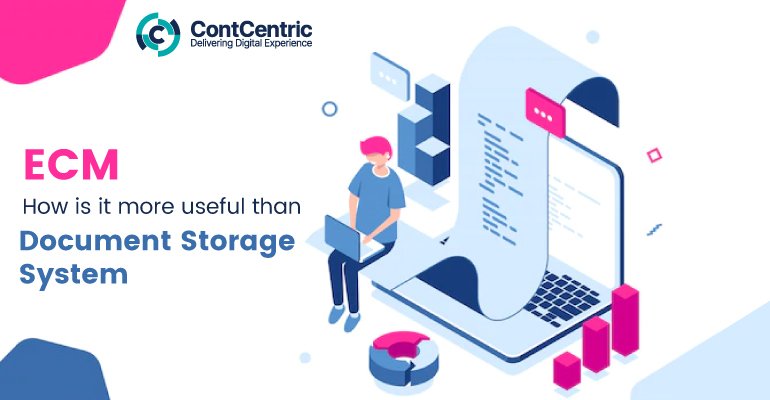Content migration requires a thorough strategy and in-depth planning. Because moving content from existing platforms to a new digital platform is a complex task! It also depends a lot on the objective of ECM content migration – is it for replacement of the existing platform, or upgrading the platform, or for carrying out infrastructure changes. Every organization has content of different magnitude and based on the objective, we can identify the best way for content migration.
It is important to avail of reliable ECM content migration services in India, to ensure safety and efficiency! A good enterprise content management company will be able to acquire content from all the different legacy sources and consolidate it over CMS such as Alfresco Content management system. And there are different ways – different migration models for implementing this.
Content Migration Models
The three major models for migrating enterprise digital content are – Big Bang Model, Parallel Model, and Incremental Model. You need to choose the migration model wisely, to ensure there is no data loss or data damage as well as system damage.
BIG BANG MODEL
Systematic content migration in one go – from the old to the new platform
PARALLEL MODEL
Content migration while both old and new systems are running parallel
INCREMENTAL MODEL
Gradual content migration in small, incremental datasets over time.
The Big Bang model of content migration is highly risky and is virtually useless when it comes to massive datasets. Also, it has high downtime and glitches once content is migrated to the new platform. The parallel model is good but it requires you to run two platforms parallel which adds up cost and energy. For big organizations, an incremental model is ideal. It has its own challenges and issues, but it remains the best way to migrate enterprise content on platforms such as Alfresco.
Enterprise Content Migration to Alfresco
While migrating the enterprise content to Alfresco, one of the biggest factors you should consider is – DOWNTIME. There will be service disruption but it should be controlled and brought to a minimum. There should be thorough planning for your existing and future business content management systems. The ultimate goal here is minimum impact on the business operations and ease of access for the users, in the future. Here is how it happens.
5 Stages Of Content Migration
Each of these stages is equally important and they will have an overreaching effect on the ease of using the content in the future.
Stage 1 – Content Discovery and Data Inventory
Stage 2 – Migration Process Planning
Stage 3 – Ensuring Data Quality
Stage 4 – Delta handling and Change Management
Stage 5 – Execution, Testing, and Verification
Ultimately, the enterprise content migration process will include so many different processes such as analysis, mapping, high-level design, detailed design, configuration, testing, deployment, etc. And every stage will be built upon the strong foundation of the preceding stages.
#Stage 1: Content Discovery and Data Inventory
CONTENT DISCOVERY
The first step is to let the technical and functional teams – including users, stakeholders, and IT staff – have an insight into the legacy content system. The teams can identify the location, volumes, and migration targets for the content through workshops and discovery sessions. This exercise helps not only in the discovery of content but also helps the organization realign the business model and business decisions. Your enterprise content management consultant’s responsibility is to guide you through this process and help your team identify risks and plan for any eventualities.
DATA INVENTORY
The content inventory is a quantitative and qualitative assessment of every single type of content in the existing repositories. A report is prepared with all the information about the classification of content and the planning for its migration. This exercise allows you to launch an effective content migration strategy by breaking the content down into manageable chunks.
At the end of Stage – 1, you should have at least these collaterals ready…
- Content Inventory Report
- Content Inventory Analysis
- Content Security Audit
#Stage 2: Migration Process Planning
Every planning requires a unique approach and blend of automated tools and manual human processes. But overall, you must be clear about at least the following aspects of the entire migration process.
-
ORGANISATION EXPECTATIONS
It all depends on the understanding and expectations of all the stakeholders who are associated with or will be impacted by content migration. To achieve this, a series of interviews and brainstorming sessions should be planned.
-
IDENTIFYING MIGRATION ASSETS
The assets involved in the migration should be identified and analyzed for different parameters such as – information architecture, content sources, business processes, regulated content, and compliance standards.
-
KEEPING EYE ON THE DETAILS
Understanding all the complex elements in detail is vital for planning a successful migration. Keeping an eye on any associated dependencies such as content complexity, relationships, quality, and volume; is necessary to have a detailed understanding.
-
DATA SECURITY
The security of the data is very important. The content might have sensitive information that might expose unsafe conditions, ultimately leading to business loss. Such content should be tagged and secured with extra care.
-
RISK MITIGATION
To mitigate the migration risks, you should run a beta migration program using a representative set of the content, in a safe environment. This can be done by building and testing a prototype system. You should also be prepared with a contingency plan.
-
PERMISSION MAPPING
You also need to synchronize the different authorities used for authentication and authorization purposes. Also, a strategy needs to be prepared to define how permissions on the source legacy systems will map to the Alfresco permission model.
At the end of Stage – 2, you should have at least these collaterals ready
- Migration Plan
- Migration Infrastructure
- Migration Tool Kit
#Stage 3: Ensuring Data Quality
You need to assess what is important and what is useless for you. In fact, the content usually evolves during the content migration process such as data normalization or enrichment. It allows you to get innovative while doing digital transformation and create a new content management model for your organization.
Usually, enterprises have unstructured data which is accumulated over the years because of the lack of systemic data management. So, it requires a more concerted effort to integrate this data into a unified digital content structure in such a case.
During this stage you should also be prepared with a content clean-up plan, to eliminate duplicate content and ROT (redundant, obsolete, and trivial) data. This is important to make the data more relevant and save storage space.
At the end of Stage – 3, you should have at least these collaterals ready…
- Content Inventory Clean-up Plan
- Content Enhancement Plan
- Content Archiving Plan
#Stage 4: Delta handling and Change Management
DELTA HANDLING
Delta refers to the content which is added, removed, or modified during a specific delta time period. Having a system that helps you define and distinguish such added, removed, or modified data is very important. Usually, a time-stamp can help in spotting delta.
CHANGE MANAGEMENT
The delta content generated during the migration process needs to be managed and done through Change Management. You should have this system to rescan the content to identify the new content and existing content.
At the end of Stage – 4, you should have at least these collaterals ready…
- Delta Content Migration Plan
- Freeze Cycles Definitions
#Stage 5: Execution, Testing, and Verification
EXECUTION
The execution of the content migration process is carried out through execution cycles. Several execution cycles are executed for migrating data without compromising its integrity, accessibility, and manageability.
TESTING
Testing should be done on different interfaces, to see if the content is correctly displayed. Also, testing by the end-users is necessary because they have experience of using it daily and hands-on knowledge of the content. Their testimony is the ultimate success.
VERIFICATION
Verification by subject matter experts and business units should be done to ensure that the content has not been compromised. Also, you need to create checklists to effectively check and track the data. The actual results of the verification process should be saved in a report to guarantee the quality of the migrated data and completion of the migration process.
At the end of Stage – 5, you should have at least these collaterals ready…
- Content Migration Report
- Content Validation Report
After all the five stages are finished, one important task remains – Housekeeping. This is the process of archiving all the tools and processes used for content migration. This is important because you can later analyze the processes and if required, redo some processes. So, the tools, protocols, mappings, and scripts should be saved for future utility; and a comprehensive report should be created for reference.
To Know More About: What It Takes to Migrate Alfresco Content and Database from Community 4.2 (PostgreSQL) to Enterprise 5.2 (MySQL)
—
By now you must have understood that enterprise content migration is a very complex process that depends on so many different factors. But with a good strategy and planning, it can be executed well. The need for organizations to leverage the latest web content management and enterprise content management is perennial. Every organization would want to change and upgrade its content platform. But you have to wait for the right time, the right technology, and the right Enterprise content management company to give you reliable content migration services.
Get in touch with ContCentric – An enterprise content management company in the USA, UK, and India.









